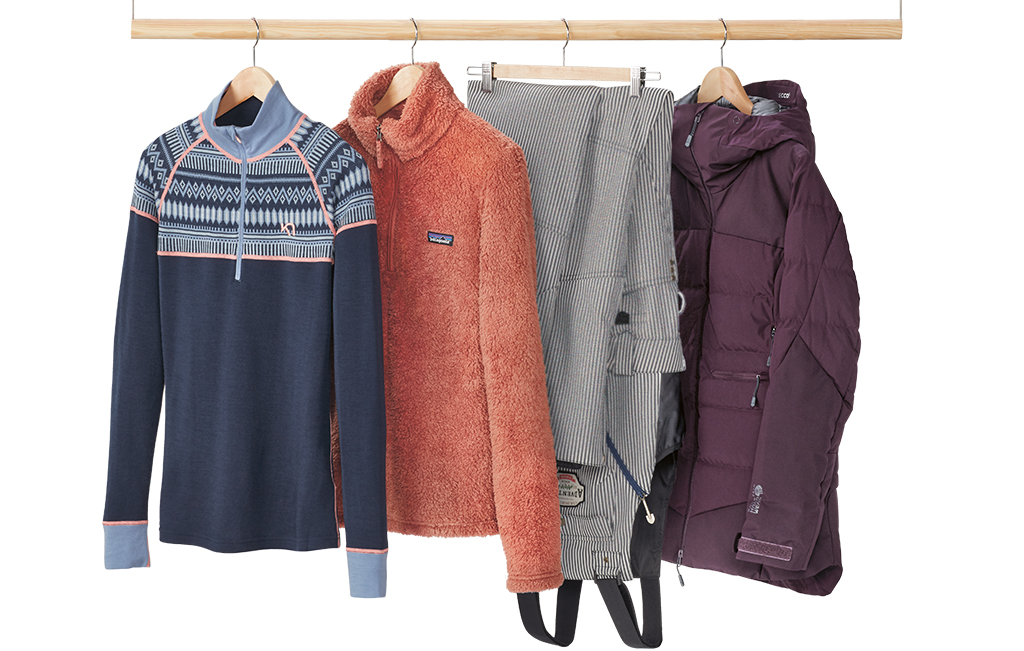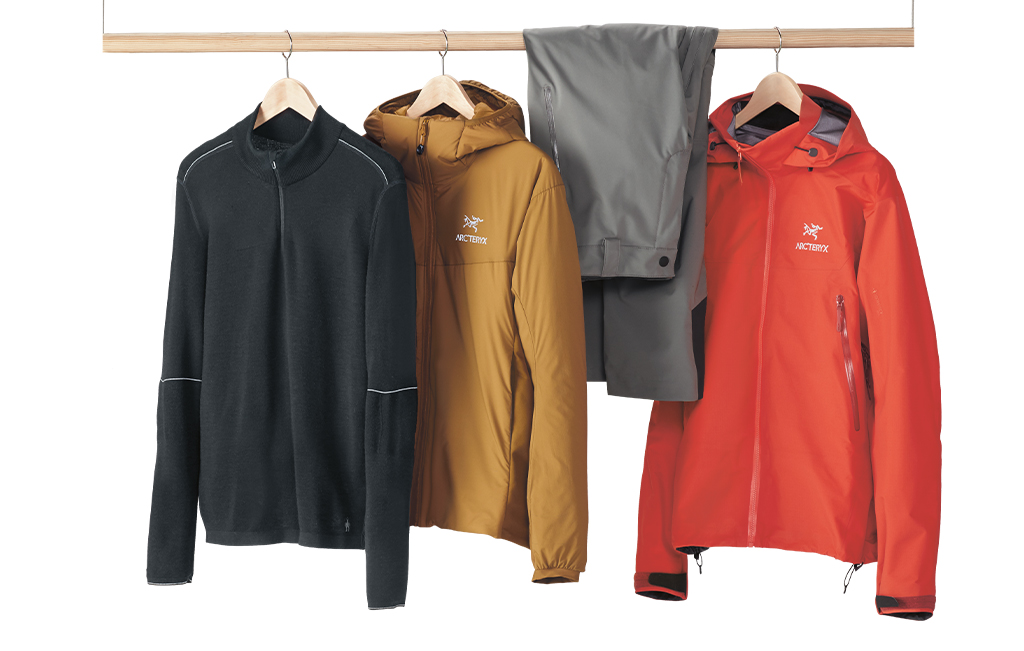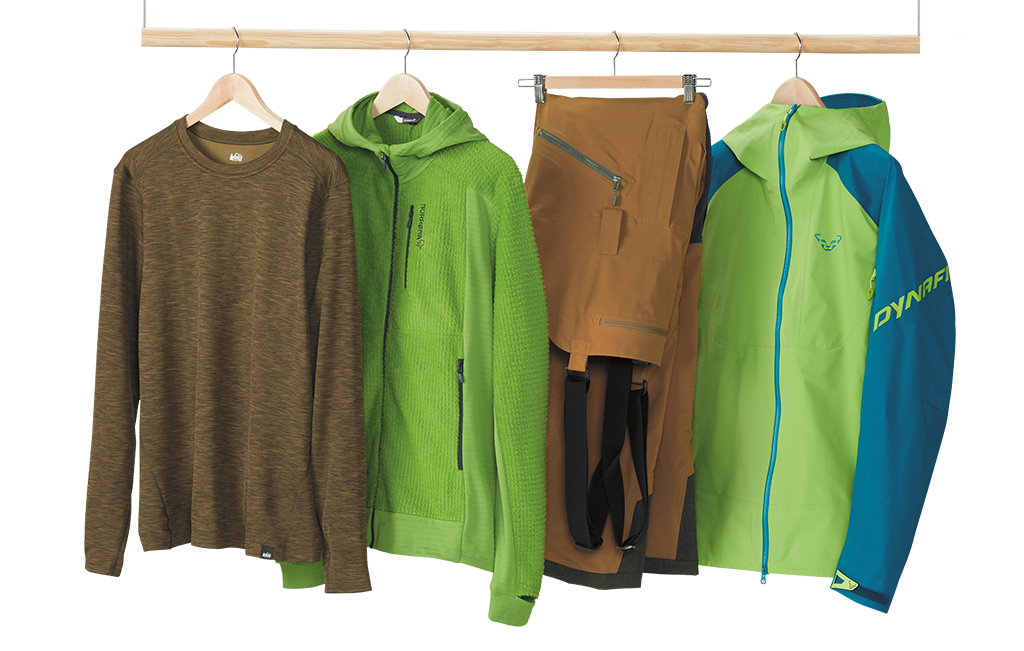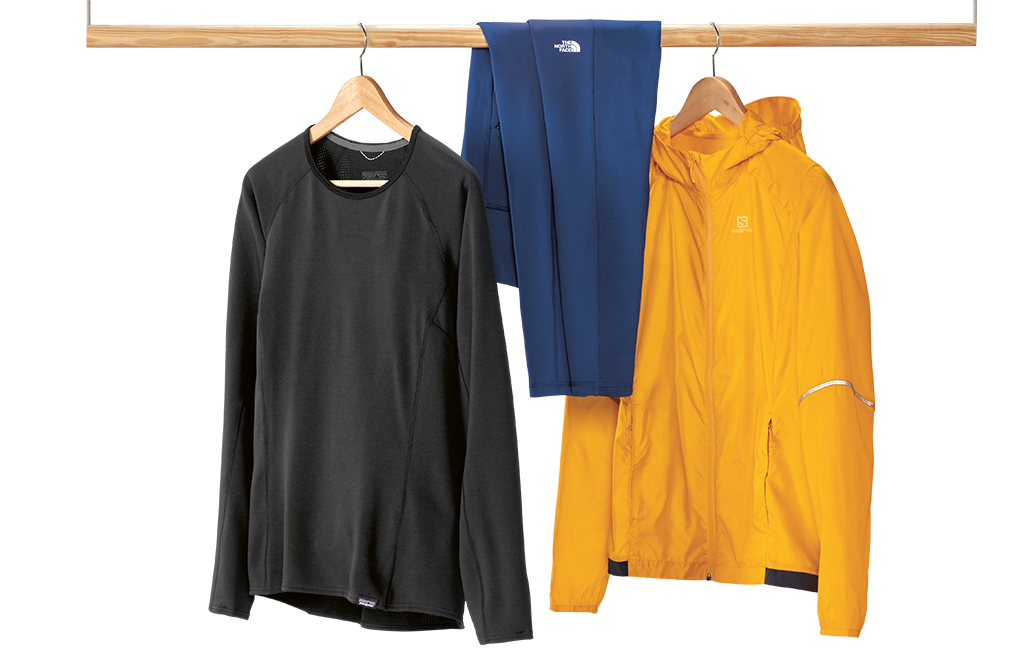A version of this story appeared in the winter 2020 issue of Uncommon Path.
A layering system tends to incorporate three pieces: a base layer, a mid layer and an outer layer. Worn closest to your skin, the base layer should have a snug fit; it wicks perspiration away from your body to prevent your core temp from cooling. Next, the mid layer acts as your insulation, or your warming item. Last, the outer layer blocks wind, rain and snow. Use this guide to create the perfect layering system for your winter activity.
Layering for Snow
Low Intensity
Ice fishing, belaying, hunting in a blind, an easy walk around the block

From left: Kari Traa Lokke Half-Zip Base Layer Top (Women’s), $120; Patagonia Los Gatos Quarter-Zip Fleece Pullover (Women’s), $109; PICTURE ORGANIC CLOTHING Seattle Bib Snow Pants (Women’s), $219; Mountain Hardwear Direct North GORE-TEX WINDSTOPPER Down Jacket (Women’s), $400
Materials
Merino wool has one of the best warmth ranges of any fabric, thanks to the natural crimp (or zigzag) of its fibers. It traps air in tiny pockets, which warms up fast from body heat.
Synthetic fleece is usually made of polyester. It’s highly breathable and dries fast, and because it typically isn’t bulky, you can easily slide it between other layers.
Down is the fluffy stuff between the bird’s body and feathers. It creates tons of pockets of air (an ounce of down can have as many as 2 million filaments) for the best warmth-to-weight ratio when it’s dry. (It loses loft when wet.)
Mid-Low Intensity
Resort skiing, building a snowman, a moderately paced walk

From left: Smartwool Intraknit Merino Quarter-Zip Base Layer (Men’s), $150; Arc’teryx Atom Insulated Hoodie (Men’s), $300; Helly Hansen Legendary Insulated Snow Pants (Men’s), $200; Arc’teryx Beta AR Jacket (Men’s), $600
Materials
Body-mapped base layers use a construction that places different weights of fabric across the garment. Heavier materials go where you require more insulation, like your torso, while lighter materials go where you sweat, like your back and underarms.
Synthetic insulation is composed of man-made threads that are spun to create pockets of air, mimicking down. It’s not as compressible as down, but it’s warm when wet, dries quickly and is usually less expensive.
Waterproof/breathable shells (like GORE-TEX) often use a three-layer sandwich: The interior liner wicks sweat off your skin through a membrane, and the face fabric repels moisture.
Mid-High Intensity
Snowshoeing, backcountry skiing, fat-biking, ice climbing, a snowball fight

From left: REI Co-op Midweight Long-Sleeve Base Layer Crew Top (Men’s), $54.95; Norrona Lofoten Alpha 120 Zip Hoodie (Men’s), $159; Outdoor Research Hemispheres Bib Snow Pants (Men’s), $599; Dynafit Radical GORE-TEX Jacket (Men’s), $499.95
Materials
Synthetic base layers are often lighter and more breathable than wool, making them great at wicking sweat from your skin and drying quickly. But they aren’t as resistant to body odor.
Hybrid mid layers take the best of your base and mid layers to create breathable insulation. Typically, down or synthetic insulation is used around your core, while the remaining areas are constructed with thinner, more breathable fabrics.
Performance waterproof/breathable shells let sweat escape and repel moisture. This one uses GORE-TEX C-KNIT, a three-layer sandwich with a more breathable and stretchy internal liner.
High Intensity
Running, cross-country skiing, any cardio workout

From left: Patagonia Capilene Midweight Crew Base Layer Top (Women’s), $59; The North Face Winter Warm High-Rise Tights (Women’s), $85; Salomon Agile Wind Print Hoodie
(Women’s), $90
Materials
Nylon is highly abrasion-resistant and strong enough to be worn alone (unlike a base layer). Its fibers have solid elastic-recovery behavior and wick sweat.
Ultra-breathable synthetics, like Capilene from Patagonia, sacrifice heat retention in the name of breathability, wicking and quick-drying capabilities.
Polyester on its own isn’t waterproof (and barely water-resistant), but it excels at blocking wind while allowing sweat vapor to escape. Plus, it’s light enough for cardio activities.
Layering for Dry Weather
Cool Weather
Hiking in temperatures between 30°F and 50°F
Featured Products:
- Icebreaker 200 Oasis Crew Top
- Fjallraven Abisko Trekking Tights
- REI Co-op Flash Insulated Vest
- REI Co-op Trailmade Jacket
Look into a base layer with offset shoulder seams like the 200 Oasis Crew. Such tops have seams that won’t chafe beneath your backpack straps. Combined with merino wool, which is naturally abrasion resistant, this shirt should ensure your comfort on the trail.
Pants with built-in armor like the Abisko Trekking Tights HD will withstand natural wear and tear longer. These specific tights use aramid, an insanely strong, heat-resistant class of synthetic fibers (commonly referred to under the brand name of Kevlar). Frequently used in body armor and aerospace fabrics, aramid is woven into hiking apparel throughout abrasion-prone areas for protection.
Insulated vests are the do-it-all layer for active warmth. The Flash Insulated Vest uses PrimaLoft Silver Eco insulation made with 70 percent post-consumer recycled content, which surrounds your core where you need warmth the most. The lack of arms prevents overheating when you’re exerting yourself on tough climbs.
Cover it all with a lightweight shell than can easily stow away in your pack like the REI Co-op Trailmade Jacket.
Cold Weather
Hiking in subfreezing temperatures
Featured Products:
- Odlo Warm Half-Zip Turtleneck
- REI Co-op Base Layer Bottoms
- REI Co-op 650 Down Jacket
- Arc’teryx Beta SL Jacket
- Mountain Hardwear Chockstone Alpine Pants
Hybrid base layers like the Warm Half-Zip Turtleneck are constructed from a blend of wool and synthetic. This means they grant the odor-resistance and warmth of wool combined with the durability of synthetic fibers for long-haul days on the trail.
Pair a hybrid base layer with base layer tights like the Merino Midweight Bottoms. They cut off the leg at the shin like capris, which prevents bunching and hot spots around your socks. You still get the warmth and moisture management of a full-length base layer bottom.
Go for a softshell pant like the Mountain Hardwear Chockstone or Arc’teryx Gamma Pants. Softshell fabrics (like the 91 percent nylon/9 percent elastane blend here) maintain a high level of warmth like hardshells but are more breathable. Softshells also allow for a full range of motion while climbing steeps. Note: They’re often heavier than hardshells.
Pack a puffy like the REI Co-op 650 Down Jacket and a shell like the Arc’teryx Beta SL Jacket just in case.
